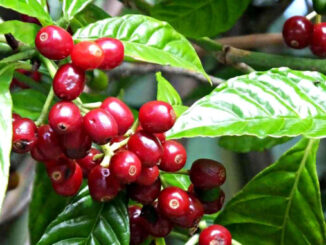
Arabica coffee (Coffea arabica) is the world’s most popular coffee species, accounting for nearly 70% of global coffee production.
It’s prized for its smooth flavor, floral aroma, and natural sweetness, making it the top choice for specialty coffee roasters.
Over centuries, Arabica has evolved through natural mutations, regional adaptation, and crossbreeding, giving rise to dozens of unique varieties.
Let’s explore the main Arabica-derived varieties and hybrids that shape the world of coffee today.
🌍 The Origin of Arabica Coffee
Arabica originated in the Ethiopian highlands, where it still grows wild.
It was domesticated in Yemen around the 9th century, from where it spread to Asia, Africa, and Latin America.
All Arabica varieties can trace their lineage back to two ancient cultivars:
Typica and Bourbon — the genetic parents of nearly every modern Arabica strain.
🌿 The Two Main Lineages of Arabica Coffee
1. Typica Line
Typica is one of the oldest and purest Arabica types, first cultivated in Yemen, then brought to India, Indonesia, and the Americas.
It produces tall trees with long, narrow leaves and excellent cup quality, but lower yield.
Varieties derived from Typica include:
- Jamaica Blue Mountain – Smooth, balanced, and sweet; world-famous for quality.
- Kona (Hawaii) – Mild acidity, nutty sweetness, and a delicate aroma.
- Maragogipe – A natural mutation with giant beans and mild flavor.
- Caturra – A compact, higher-yield Typica mutation discovered in Brazil.
- Catuaí – A hybrid of Caturra and Mundo Novo, productive and flavorful.
- Pacamara – A cross between Pacas (Bourbon mutation) and Maragogipe; known for its large beans and complex taste.
2. Bourbon Line
The Bourbon variety originated from Typica plants taken from Yemen to Bourbon Island (now Réunion) by the French in the 1700s.
It became the genetic base for many of today’s most prized coffees.
Bourbon-derived varieties include:
- SL28 & SL34 (Kenya) – Bright acidity, citrus notes, and high cup quality.
- Pacas (El Salvador) – A natural Bourbon mutation with sweet, balanced flavor.
- Mundo Novo (Brazil) – A natural hybrid of Typica and Bourbon; productive and rich-bodied.
- Caturra – Another Bourbon mutation; compact and high-yielding.
- Villa Sarchi – A Costa Rican Bourbon mutation with lively acidity.
- Catuai – Derived from Caturra × Mundo Novo, ideal for low altitudes.
🧬 Notable Arabica Hybrids and Modern Crosses
As climate challenges and diseases like coffee leaf rust increased, scientists began developing hybrids that combine Arabica quality with disease resistance and adaptability.
Here are the most important modern Arabica-based hybrids 👇
1. Catimor
- Cross between Caturra (Arabica) and Timor Hybrid (Arabica × Robusta).
- Resistant to leaf rust and very productive.
- Flavor: Medium body, herbal or nutty tones.
- Widely grown in Asia and Central America.
2. Sarchimor
- Cross between Villa Sarchi (Bourbon line) and Timor Hybrid.
- Combines excellent resistance with balanced cup quality.
- Common in Brazil, India, and Central America.
- Flavor: Mild, sweet, and clean finish.
3. Hybrid de Timor (Timor Hybrid)
- A natural cross between Arabica and Robusta found on Timor Island.
- Extremely disease-resistant, strong-growing, and vital for modern breeding.
- Flavor: Earthy, slightly woody, less aromatic than pure Arabica.
4. Arusha
- A Typica-type variety found in Tanzania.
- Known for its bright acidity and fruity notes.
- Performs well at mid-to-high altitudes.
5. Geisha (or Gesha)
- Originated from Ethiopia, rediscovered in Panama.
- Extremely sought after for its floral, tea-like aroma and complex sweetness.
- Grown in Panama, Ethiopia, and Costa Rica.
- High altitude variety requiring ideal care.
6. Obatá
- Developed in Brazil as a hybrid of Sarchimor lines.
- Combines disease resistance with good cup quality.
- Flavor: Sweet, smooth, slightly nutty.
7. Colombia Varieties (Colombia, Castillo, Tabi)
- Developed by Cenicafé in Colombia.
- Aim: Combine Bourbon/Typica flavor with resistance to leaf rust.
- Castillo is now Colombia’s most widely planted coffee.
- Flavor: Clean, bright, and balanced, though less complex than older lines.
8. Ruiru 11 and Batian (Kenya)
- Crosses involving SL28, SL34, Timor Hybrid, and other Arabica strains.
- Designed for high yield and rust resistance.
- Ruiru 11 has a nutty, sweet cup; Batian offers fruitier, more complex notes.
💧 Environmental Adaptability
Arabica varieties differ greatly in environmental preference:
- Typica and Bourbon lines thrive at high altitudes (1,200–2,000 m).
- Catimor and Sarchimor hybrids perform well in low to mid-altitude farms.
- Geisha and SL varieties require stable climates and rich volcanic soils.
This adaptability has made Arabica suitable for regions across Latin America, Africa, and Asia, each imparting unique flavor signatures.
⚗️ Flavor Summary by Lineage
Typica Line: Smooth, sweet, and balanced — the classic profile of high-quality coffee.
Bourbon Line: Bright, fruity, and aromatic with higher acidity.
Hybrid Lines: Resilient, productive, and often mild but less complex in flavor.
❤️ Final Thoughts
The Arabica coffee species is the cornerstone of global coffee culture.
From the ancient Typica and Bourbon varieties to modern hybrids like Catimor and Geisha, Arabica continues to evolve — blending tradition, innovation, and resilience.
Each variety offers a unique story in your cup — a journey of geography, genetics, and passion that defines the art of coffee.
☕ Arabica coffee — timeless elegance with endless diversity.
DeliciousPath: Enjoyment in Every Moment
Explore the Gourmet on Board category for exquisite flavors that elevate your meals, even when you’re on a boat, and the Coffee category for aromatic coffee blends that make every moment special. DeliciousPath is here to turn every experience into something unforgettable!
























